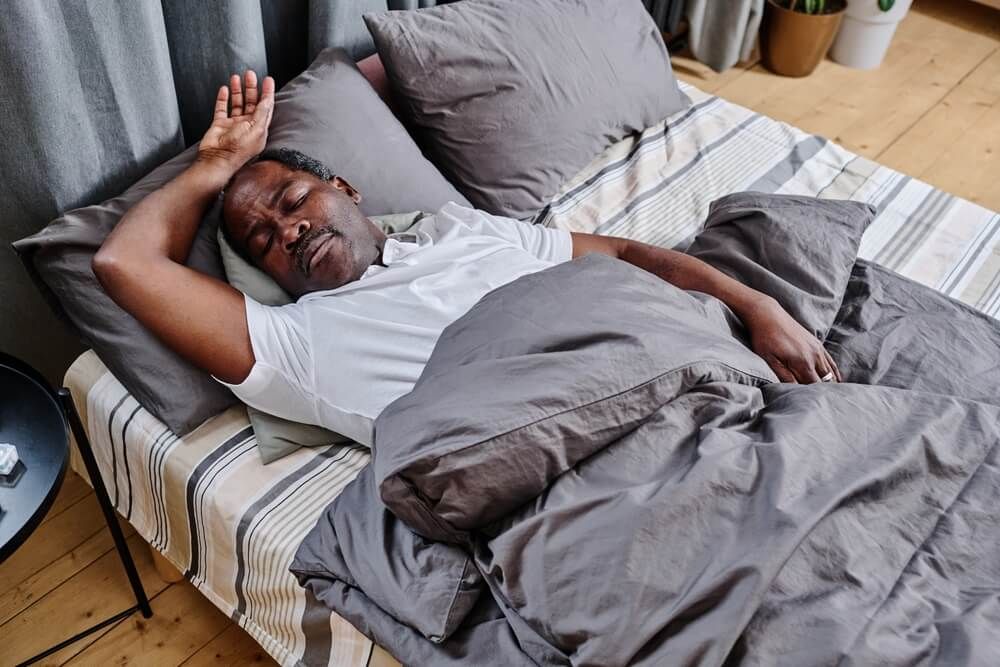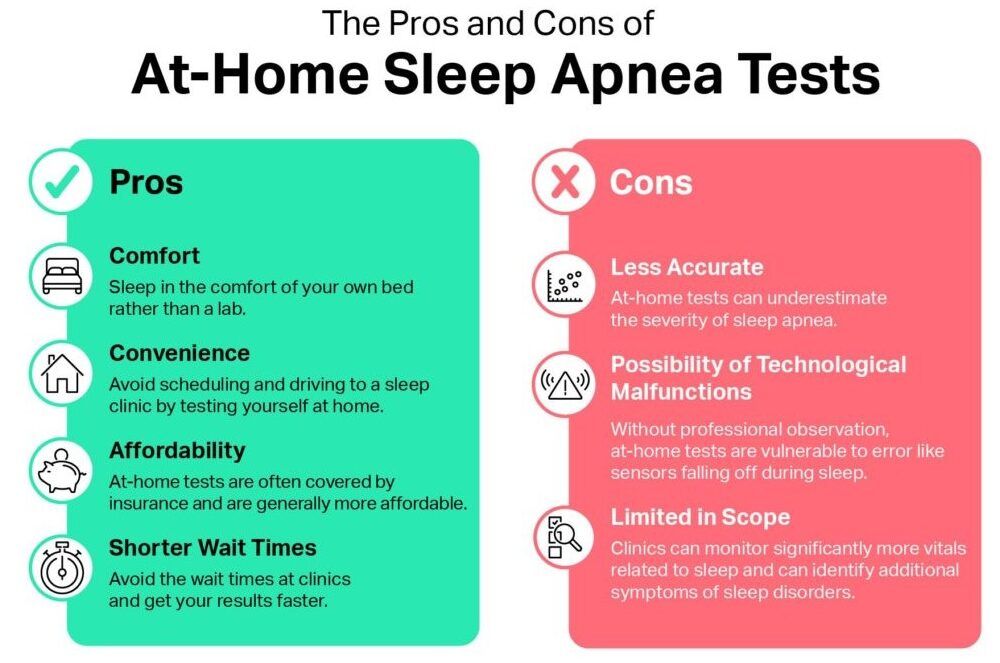
A sleep study, also known as a polysomnography, is a test that is used to diagnose sleep disorders such as sleep apnea, insomnia, restless legs syndrome, and narcolepsy. A home sleep study, also known as a portable sleep study or a sleep apnea test, is a test that can be done in the comfort of the patient’s own home. The patient will be given a device that they will wear overnight that will monitor their breathing, oxygen levels, heart rate, and other vital signs. The patient will be given instructions on how to use the device and how to prepare for the test. The data from the device will be analyzed by a sleep specialist who will make a diagnosis and recommend treatment options if necessary. Home sleep studies are usually recommended for patients with suspected sleep apnea or other less complex sleep disorders.

The type of sleep study recommended (in-lab or at home) will depend on the patient’s symptoms and the suspected sleep disorder. A sleep specialist can help determine which type of sleep study is appropriate for the patient.
Comprehensive monitoring: In-lab sleep studies typically monitor a wider range of physiological parameters than home sleep studies, which can provide a more complete picture of the patient’s sleep health.
Immediate intervention: If a patient experiences a significant sleep-related event, such as an apnea or hypopnea, during an in-lab sleep study, the technician can intervene immediately to adjust the equipment or provide support. In contrast, home sleep studies may not provide immediate feedback or intervention.
Expert interpretation: In-lab sleep studies are typically interpreted by experienced sleep specialists who can provide a detailed analysis of the patient’s sleep health. Home sleep studies may be interpreted by general practitioners or less experienced technicians, which can result in inaccurate or incomplete diagnoses.
Complex sleep apnea: Complex sleep apnea is a type of sleep apnea that occurs when a patient has both obstructive sleep apnea and central sleep apnea. This condition requires more comprehensive monitoring and cannot be accurately diagnosed with a home sleep study.
Narcolepsy: Narcolepsy is a neurological disorder that affects a person’s ability to regulate sleep-wake cycles. It is characterized by excessive daytime sleepiness and sudden, uncontrollable episodes of sleep. Narcolepsy cannot be accurately diagnosed with a home sleep study.
Insomnia: Insomnia is a sleep disorder characterized by difficulty falling asleep or staying asleep. While a home sleep study can monitor a patient’s sleep quality, it cannot diagnose the underlying causes of insomnia, such as anxiety or depression.
Periodic limb movement disorder: Periodic limb movement disorder is a sleep disorder characterized by repetitive, involuntary movements of the legs or arms during sleep. While a home sleep study can monitor a patient’s leg movements during sleep, it cannot diagnose periodic limb movement disorder or other movement disorders.
It is important to note that a home sleep study typically monitors fewer parameters than an in-lab sleep study, which can result in missed or incomplete data. For example, a home sleep study may only monitor respiratory function, while an in-lab study can also monitor brain waves, muscle activity, and eye movements. Home sleep studies rely on the patient to correctly set up and use the monitoring equipment, which can lead to technical difficulties or errors.
In contrast, an in-lab sleep study is administered and monitored by trained technicians who can troubleshoot any issues that arise. The patient’s sleep environment can also affect the accuracy of a home sleep study. For example, if the patient’s home is noisy or they are unable to sleep comfortably in their own bed, the data collected by the home sleep study may be inaccurate.
Overall, while home sleep studies can be a useful tool for diagnosing certain sleep disorders, they may not be as comprehensive or accurate as in-lab sleep studies. A sleep specialist can help determine which type of sleep study is most appropriate for the patient’s needs.
Quality sleep solutions are just a click away. Say goodbye to excuses and hello to better sleep. Schedule your Televisit with Holistic Sleep Restoration today!
Congratulations on taking the next step toward understanding your sleep health! Here’s what you can anticipate after your physician has ordered a home sleep study:
Our billing department will submit your home sleep study to your insurance provider for prior authorization. This process typically has a high approval rate, but it’s essential to be aware of potential co-insurance responsibilities. Please do your due diligence during this period.
Once your study is approved, please allow one to two weeks for the insurance clearance process. After clearance, your co-insurance payment will be required. This is your responsibility and an important step to ensure the study’s completion.
After making your co-insurance payment, our staff will arrange for you to collect the sleep study device. You can either pick it up at the Conyers Sleep Center or Loganville Sleep Center. Alternatively, we can mail the device to you, with the shipping cost covered by you.
Follow the provided instructions to conduct the home sleep study in the comfort of your own home. Once the study is complete, return the device to the designated sleep center.
Your home sleep study results will be available within 48 hours after the study’s completion.
Schedule another virtual consultation to discuss the results with your physician. This consultation is vital as it allows you and your physician to collaboratively decide on the most suitable next steps based on the findings.
During this process, your proactive engagement is invaluable. Stay informed, ask questions, and follow the instructions provided. Your commitment to understanding your sleep patterns is a crucial step toward achieving restful and rejuvenating sleep. We’re here to support you every step of the way.
Encountering issues with your home sleep study device can be frustrating, but there’s no need to panic. Here’s a step-by-step guide to help address the problem:
First and foremost, remain calm. Technical issues are common and can often be resolved.
Refer to the video tutorial provided with the device. Many problems have simple solutions outlined in the tutorial.
Check the battery. Ensure it’s properly charged and not depleted. Follow the troubleshooting steps in the device manual or the tutorial. Attempt to resolve the issue based on the provided guidelines.
Allocate a reasonable amount of time (around 30 minutes) to troubleshoot the problem. Some issues might take a little time to resolve.
If you’re unable to fix the issue after trying the troubleshooting steps, don’t worry. Return the device the following day. Remember, technical glitches are not uncommon, and it’s not a reflection of your ability to use the device.
The positive news is that if your home sleep study encounters technical difficulties, your insurance will often cover the cost of transitioning to an in-lab study.
In-lab studies offer a controlled environment, ensuring accurate results even if the home study didn’t go as planned.
Don’t hesitate to reach out to the sleep clinic or your healthcare provider if you encounter issues. They’re there to support you through this process. Stay patient and proactive, and rest assured that a solution will be found to ensure the accuracy of your sleep study results.
It’s important to understand the responsibility associated with the home test device. If you fail to return the device within the specified timeframe, the following consequences apply:
You will be obliged to reimburse the full purchasing price of the device as per the contract agreement signed with the sleep clinic.
This reimbursement ensures that the clinic can replace the equipment, enabling them to continue providing services to other clients.
The obligation to return the device within the agreed timeframe is outlined in the contractual agreement to maintain fairness and allow the clinic to serve all their patients efficiently.
Failure to adhere to this agreement may result in financial responsibility to cover the cost of the unreturned device.
Always be aware of the return deadlines specified in the agreement.
If you encounter difficulties, communicate promptly with the clinic. They might be able to offer solutions or extensions if there are valid reasons for the delay.
Understanding and complying with the terms of the agreement ensures a smooth process for all parties involved. It’s essential to be responsible and timely in returning the device, allowing the clinic to continue offering their services effectively.